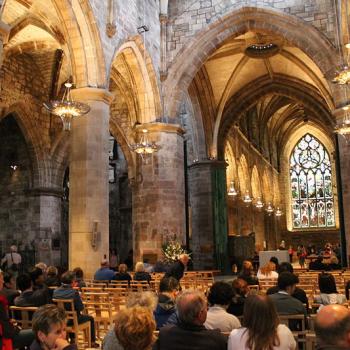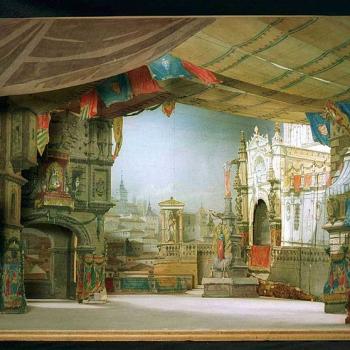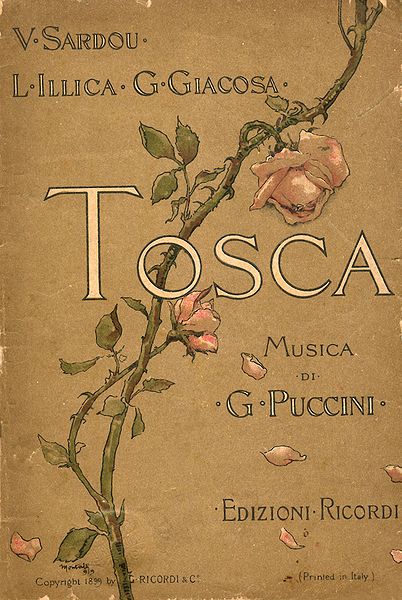As an opera lover, I am quite accustomed to musical settings of religious texts. In fact, scenes like the Easter hymn from Cavalleria Rusticana, or the final prayer for Mary and her court in Maria Stuarda are some of the most awe inspiring and uplifting moments in opera. The same thing can even be said for the Eucharist at the end of the first act of Parsifal, even though—in typical Wagnerian fashion—it can drag on. All this is to say that when I first came across Francis Poulenc’s Dialogues des Carmélites (Dialogues of the Carmelites), I had been lulled into a false sense of security. That opera, from 1957, tells the story of The Martyrs of Compiègne: 16 Carmelites cloistered just outside Paris, who were beheaded during The Reign of Terror merely ten days before Robespierre met the same fate. The most famous scene of the work is the finale, where the nuns mount the scaffold and in the face of death, sing the “Salve Regina.”
Before watching the opera for the first time—on DVD from the Sydney Opera House, with no less than Joan Sutherland in the cast—I was prepared for a contemplative final scene; one that was at worst sobering but inspiriting. I was fully unprepared for the harrowing experience that awaited me. You see, as each singer walked off stage, their exit was marked by the crunch of the guillotine cued by the orchestral percussion. There was such a disconnect between the hymn in praise of the Holy Mother and the gruesome deaths of the innocent clergy that it jars me even to this day. I always joke that Dialogues of the Carmelites is one of my favorite operas that I never want to see performed live. Upon closer examination however, this horrifying hymn setting is exactly the point.
You see, Dialogues of the Carmelites is much more than a straightforward retelling of the martyrdom of these 16 Carmelites from Compiègne. The actual historical events occurred in July of 1794. Those 16 martyred comprised 11 Discalced Carmelite nuns, 3 lay sisters, and 2 externs. Of these, three women feature as characters in the opera 1. From the time of their execution, to the opera’s world premiere at La Scala in 1957, the story of the sisters has become a novella, a play, and then finally an opera. With each iteration, the actual historical events were obscured, as the story became more a meditation on life and death in all its forms. Not only is it about the relationship between life and death, but also what it takes to face death with courage. Therefore, it is only too appropriate that the final scene should be as haunting as it is.
With that in mind, it is worth noting that the actual events have more than a tinge of myth about them. On July 17, 1794, 16 Carmelite nuns arrived at the Place du Trône Renversé to fulfill their death sentence as traitors to the state. Their crime, according to the revolutionary council, was “gathering illegally, spreading fanatical writings opposed to freedom.” The council also branded them “openly seditious with desire to see the people of France once more in the chains of tyrants. To see liberty drowned in torrents of blood, which their treacherous plots had brought about in the name of God.” All that to say, they simply gathered in prayer, and for that they deserved death.
The clergy was the hated second estate, which many saw as linked to the nobility. Religious communities had to take an oath of fealty to the revolution, and famous cathedrals like Notre Dame in Paris would become temples to the Goddess of Liberty. The revolutionaries weren’t wrong about the ties between the nobility and the clergy, but not everyone noble who joined the church did so for selfish reasons. For instance, Louis XV’s daughter, Princess Louise, became a nun out of her disgust with her father’s womanizing.
Previously, the sisters had voted to go through with their ordeal and become martyrs. Since the revolution took power, the hard-lined Jacobins had done away with all trappings of nobility and clergy, including titles. This affected the nobility in more obvious ways. For instance, at their executions, Louis XVI and Marie Antoinette were not beheaded as the King and Queen of France, but rather as Citizen Louis and Citizenesse Marie.
Yet, on July 17, 1794, the crowds that had assembled to watch what everyone thought would be a routine execution were confronted with 16 nuns dressed in their habits, singing hymns of praise as they arrived at the guillotine. You see, although these 16 Carmelites had become Citizenesses, their civilian clothing was dirty and would not be clean in time to be worn at the execution. Consequently, the sisters had no choice but to wear their religious garb. The Prioress, Madame Lidoine, was the first to step down from her cart. She stood at the steps of the guillotine, holding a statue of the Christ Child. One by one, her fellow sisters stepped down, knelt in front of her, to receive the blessing of martyrdom, and then ascended the scaffold. All while singing “Salve Regina.”
As a result, the onlookers lost the party spirit so familiar at other executions. Since none of the witnesses could truly enjoy themselves, there was nothing they could do except take a long hard look at the horror that was unfolding before them. It should come as no surprise that Robespierre—the architect of The Reign of Terror—who was so skilled at inflaming the mob, lost his life ten days later, ending one of the bloodiest periods in French history, that lasted a mere 10 months.
Shortly after the execution, the story of the nuns of Compiègne was written down in the memoirs of the one nun that survived, Mother Marie of the Incarnation—the sub-prioress, who also has a role in the opera. In an ironic twist of fate, the one sister who was the most adamant about going to martyrdom was not there on the day France’s revolutionary government closed the convent. Instead, she was helping her aunt—a member of the aristocracy—flee the country. Mother Marie’s memoirs were published posthumously in 1837. In 1931, the sisters’ story became the basis of The Song at the Scaffold, a novella by Gertrud von Le Fort, a religious philosopher and Catholic convert living in the shadow of Hitler. Her major contribution was the creation of Blanche de la Force, the main character of the novella who would become the lead of Poulenc’s opera. Through Blanche, the author inserted herself into the story, to see what she would do in that situation. After all, there are many similarities between France in the aftermath of the 1789 revolution and Nazi occupied Europe.
After Blanche became the central character, the story focused on how she grapples with life as it spins out of control around her. She’s a compelling character. Her very name, Blanche de la Force, points to her central dichotomy. She’s a girl who lives in fear but has unknown strength. Finally, the novella became the basis for a play by Georges Bernanos. At the time, Bernanos was terminally ill with cancer. Under his hand, political and historical events were minimized, and the challenge of facing death became central to the story. Bernanos was a philosopher in his own rite, and he introduced the notion that people take on Christ-like suffering to redeem others, or even the world, to the story.
The opera uses the metaphor of a cloakroom to describe how some people who don’t deserve a hard death are given a worse agony, as if by accident, in order to redeem others. Sometimes a cloakroom attendant may occasionally give patrons the wrong item, to the benefit of some and detriment of others. To that end, many characters serve as foils for each other. In some cases, as with Blanche, a character can have multiple foils.
One of the foils for Blanche is the old Prioress, Madame de Croissy, who dies an extremely agonizing death. Not only does this give rise to the metaphor of the cloakroom, but it is also a way for Bernanos to insert himself into the story and face the prospect of his own terminal illness. This is similar to how Von le Fort inserted Blanche into The Song at the Scaffold, to face her own uncertain political reality. Although Madame de Croissy dies at the end of Act I, in contrast to actual events where she died with her sisterhood, she plays a very crucial role in the story. She is the one who accepts Blanche into the convent, warning her that despite the troubled times they are living through, the convent is not a place to hide from the world. Later, in the same scene, she asks Blanche what name she planned to take after professing her vows. Blanche replies that she wishes to be known as Sister Blanche of the Agony of Christ. Carmelites take these names very seriously; they believe that the name one takes conveys their personal relationship to the holy mysteries, and that they must be willing to live out the meaning of their names in everyday life. Therefore, she cautions Blanche that she must be prepared to live the agony of Christ, repeating the warning she once received, “who enters Gethsemane never leaves it. Do you have the courage to remain until the end, a prisoner of the most holy agony?” These words were spoken to Madame de Croissy when she had chosen the same name as a novice.
The fact that they share the most holy agony is yet another parallel which strengthens the reciprocal relationship between the two women. On de Croissy’s deathbed, Blanche witnesses the Prioress blaspheme in her distress. While it doesn’t diminish the gravitas of Blanche’s death by guillotine, it does assign her the more merciful of the two deaths, and in a sense the courage to face it.
This is something that happens to Blanche throughout the opera. She learns how to face death from the courage and resilience of those around her. For instance, she runs away from the convent after being the only one to vote against martyrdom. But she witnesses Sister Constance take the blame for voting no—covering for Blanche—and then beg Mother Marie to be allowed the vow of martyrdom. Much like that between Blanche and Madame de Croissy, the relationship between Blanche and Sister Constance is another focal point of the opera.
Sister Constance is very young and lighthearted; the opposite of Blanche, who is weighed down by her fears and other social pressures. Yet, when Sister Constance mentions to Blanche that she has had a dream in which they both die on the same day, the two women are linked in a similar way as Blanche is to de Croissy. In the final scene, Blanche—who had previously run away from the convent—witnesses the sisters’ death from the crowd. However, when Sister Constance recognizes Blanche from the scaffold, the two women share a moment of connection, which gives Blanche the strength to mount the scaffold herself.
The way this moment is staged differs from production to production. Sometimes, Blanche has already mounted the scaffold, having witnessed the spectacle of the other deaths. In those cases, Sister Constance typically goes to her death overjoyed that Blanche is about to join them in martyrdom. In others, it is Constance who gives Blanche to courage to go through with her ordeal. What is clear however is that the two are linked.
It is important to note that when Blanche ascends the scaffold, she does not pick up the “Salve Regina.” Instead, she sings “Veni Creator Spiritus,” a hymn of strength and fortitude, in praise of the descent of the Holy Spirit. This is a subtle, but crucial change, because it reflects the strength of the sisters’ conviction and the fact that in just over a week The Reign of Terror would end.
Dialogues of the Carmelites doesn’t have much plot. In fact, the final scene has the most action. Instead, the emphasis of the opera is on the dialogues between the sisters, the nature of death, and the overarching dialogue between the cloistered church and the troubled outside world. These conversations illuminate much about the role of faith and courage in times of adversity. The sisters decide to become martyrs with the goal of restoring normalcy to France. Given that Robespierre’s death followed ten days after their execution, it would appear they succeeded. Therefore, the story of The Martyrs of Compiègne is just as relevant today as it was in 1794. Their story of courage in the face of death still speaks to the resilience of the human spirit, especially now in these uncertain times of the COVID-19 pandemic. Times may be dark, but they show us that hope is never extinguished.
1 Carmelite Martyrs of Compiègne:
Blessed Angelique Roussel (Sister Marie of the Holy Spirit)
Blessed Anne Pelras (Sister Mary Henrietta of Providence)
Blessed Anne-Marie-Madeleine Thouret (Sister Charlotte of the Resurrection)
Blessed Catherine Soiron
Blessed Élisabeth-Julitte Vérolot (Sister Saint Francis Xavier)
Blessed Marie Dufour (Sister Saint Martha)
Blessed Marie Hanniset (Sister Thérèse of the Heart of Mary)
Blessed Marie-Anne Piedcourt (Sister of Jesus Crucified)
Blessed Marie-Anne-Françoise Brideau (Mother Saint Louis)
Blessed Marie-Claude-Cyprienne Brard (Sister Euphrasie of the Immaculate Conception)
Blessed Marie-Françoise de Croissy (Mother Henriette of Jesus), Portrayed in Dialogues of the Carmelites
Blessed Marie-Gabrielle Trezel (Sister Thérèse of Saint Ignatius)
Blessed Marie-Geneviève Meunier (Sister Constance), Portrayed in Dialogues of the Carmelites
Blessed Marie-Madeleine-Claudine Lidoine (Mother Thérèse of Saint Augustine), Portrayed in Dialogues of the Carmelites
Blessed Rose-Chretien de Neuville (Sister Julia Louise of Jesus)
Blessed Thérèse Soiron
Source:
“Carmelite Martyrs of Compiègne“. CatholicSaints.Info. 8 March 2020. Web. 3 April 2020. https://catholicsaints.info/carmelite-martyrs-of-compiegne
image credit: https://en.wikipedia.org/wiki/File:Elin_Rombo_as_Sister_Blanche_in_Dialogues_of_the_Carmelites_2011.jpg













